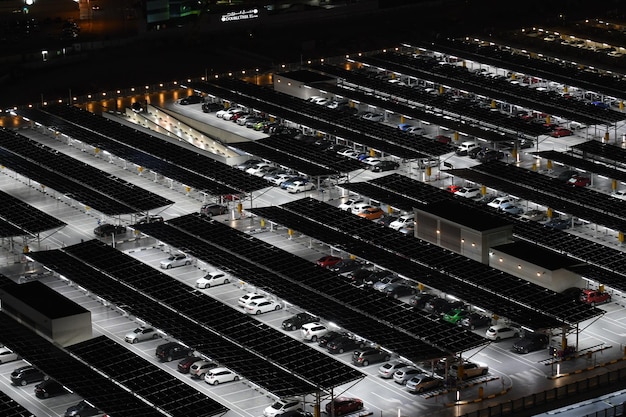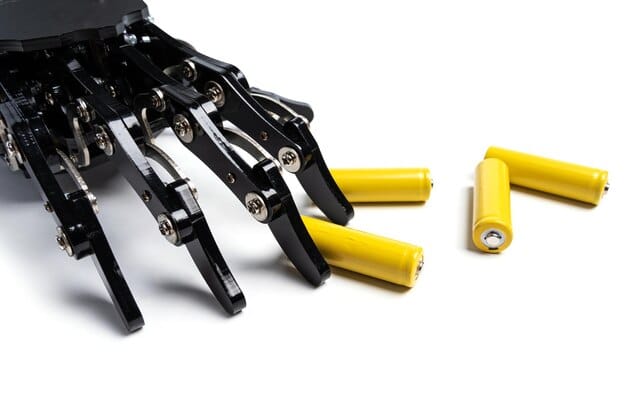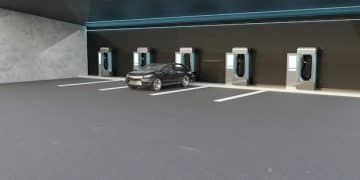US Auto Industry: Navigating the EV Transition – Challenges and Opportunities

US auto manufacturers face key challenges transitioning to electric vehicle (EV) production, including high costs, supply chain complexities, and evolving consumer demand, while opportunities arise from government incentives, technological advancements, and a growing EV market.
The automotive industry is undergoing a seismic shift, and for US auto manufacturers, the transition to electric vehicle (EV) production presents both daunting challenges and unprecedented opportunities. Understanding what are the key challenges and opportunities for US auto manufacturers in the transition to electric vehicle production is critical for stakeholders looking to navigate this transformative period.
Navigating the Electric Vehicle Transition: An Overview for US Auto Manufacturers
The shift from traditional internal combustion engine (ICE) vehicles to EVs is not merely a change in powertrain; it’s a complete overhaul of the automotive ecosystem. US auto manufacturers must contend with a range of factors, from securing raw materials to retraining their workforce.
However, this transition also opens doors to innovation, new markets, and a more sustainable future. By understanding the intricacies of this shift, US automakers can chart a course towards long-term success in the EV era.
The Pace of EV Adoption in the US Market
Electric vehicle adoption in the United States is steadily increasing, driven by factors such as government incentives, growing environmental awareness, and advancements in battery technology. However, regional disparities and charging infrastructure limitations continue to influence adoption rates.
Major US automakers are investing billions in EV production, aiming to capture a significant share of the rapidly expanding market. The success of these investments will depend on their ability to overcome key challenges and capitalize on emerging opportunities.
- Consumer acceptance influenced by range anxiety and charging availability.
- Government policies and incentives driving demand.
- Technological advancements reducing battery costs and improving performance.
Ultimately, the transition to EV production requires significant investment and strategic planning to adapt to evolving consumer expectations and technological advancements.

Securing the Supply Chain for EV Components
One of the most significant challenges facing US auto manufacturers is securing a reliable and cost-effective supply chain for EV components, particularly batteries and critical minerals. This involves navigating geopolitical complexities and investing in domestic production capabilities.
Establishing a secure supply chain is crucial for ensuring competitiveness and reducing dependence on foreign sources. This requires forging strategic partnerships, diversifying sourcing strategies, and investing in domestic mining and refining operations.
The Battery Supply Chain
The battery supply chain is the backbone of EV production, encompassing the sourcing of raw materials, manufacturing of battery cells and packs, and recycling of end-of-life batteries. Dependence on foreign suppliers for key components like lithium and cobalt presents risks.
Establishing domestic battery production capacity is essential for enhancing energy security and reducing reliance on overseas suppliers. This requires significant investments in manufacturing facilities and workforce training.
- Geopolitical tensions impacting access to critical minerals.
- Dominance of Asian companies in battery production.
- Need for sustainable and ethical sourcing practices.
Therefore, securing the battery supply chain requires a multi-faceted approach, including strategic partnerships, domestic investments, and sustainable sourcing practices.
Investing in Manufacturing Infrastructure and Workforce Training
Transitioning to EV production requires US auto manufacturers to invest heavily in new manufacturing infrastructure and workforce training. This includes retooling existing factories, building new EV-specific facilities, and retraining employees to work with electric vehicle technology.
Such investments are crucial for ensuring that US automakers can compete effectively in the global EV market and maintain their position as industry leaders.
Factory Retooling and New Construction
Existing automotive factories must be retooled to accommodate EV production, including installing new equipment for battery assembly, electric motor manufacturing, and chassis integration. Some manufacturers may also need to build entirely new facilities to meet the growing demand for EVs.
These investments require significant capital outlay and long-term planning to ensure efficient and cost-effective production. Government incentives and public-private partnerships can play a crucial role in accelerating this process.
- High costs associated with factory retooling and new construction.
- Need for flexible manufacturing processes to accommodate evolving EV technology.
- Importance of optimizing production efficiency and minimizing waste.
Thus, investing in manufacturing infrastructure and workforce training is essential for a successful transition to EV production.
Meeting Evolving Consumer Demand and Preferences
US auto manufacturers must adapt to evolving consumer demand and preferences in the EV market. This includes offering a diverse range of EV models, improving vehicle range and performance, and addressing concerns about charging infrastructure and battery life.
Understanding and catering to consumer needs is critical for driving EV adoption and ensuring long-term success in the market.
Range Anxiety and Charging Infrastructure
Range anxiety, the fear of running out of battery charge while driving, remains a significant barrier to EV adoption. Addressing this concern requires improving vehicle range, expanding the charging infrastructure, and educating consumers about charging options.
Investing in public and private charging networks, as well as developing fast-charging technology, are crucial for alleviating range anxiety and encouraging more consumers to switch to EVs.
- Consumer perception of limited EV range.
- Lack of widespread charging infrastructure.
- Need for faster charging times.
In summary, meeting evolving consumer demand and preferences necessitates innovative solutions, strategic investments, and effective communication to overcome barriers to EV adoption.

Leveraging Government Incentives and Policies
Government incentives and policies play a crucial role in accelerating the transition to EV production in the United States. These include tax credits for EV purchases, subsidies for battery manufacturing, and regulations promoting zero-emission vehicles.
By leveraging these incentives and policies, US auto manufacturers can reduce costs, stimulate demand, and drive innovation in the EV market.
Federal and State Initiatives
Both federal and state governments offer a range of incentives to support EV adoption and production. These initiatives vary by location but typically include tax credits, rebates, grants, and loans. Understanding and utilizing these incentives is essential for maximizing the economic benefits of the EV transition.
Furthermore, government regulations, such as emissions standards and mandates for zero-emission vehicles, drive demand for EVs and encourage automakers to invest in electric vehicle technology.
- Tax credits and rebates for EV purchases.
- Subsidies for battery manufacturing and charging infrastructure.
- Regulations promoting zero-emission vehicles.
Therefore, leveraging government incentives and policies is a strategic imperative for US automakers looking to compete in the EV market.
Embracing Technological Innovation and Collaboration
Technological innovation is at the heart of the EV transition, and US auto manufacturers must embrace collaboration and partnerships to stay ahead of the curve. This includes investing in research and development, partnering with technology companies, and adopting new manufacturing techniques.
By fostering a culture of innovation and collaboration, US automakers can accelerate the development and deployment of cutting-edge EV technology.
Advancements in Battery Technology
Battery technology is rapidly evolving, with advancements in energy density, charging speed, and lifespan. US automakers must invest in next-generation battery technology to improve the performance and affordability of their EVs.
Collaborating with battery manufacturers and research institutions is crucial for staying at the forefront of battery innovation and securing access to the latest technology.
- Development of solid-state batteries with higher energy density.
- Improvements in charging speed and battery lifespan.
- Reduction in battery costs through innovative materials and manufacturing processes.
In conclusion, embracing technological innovation and collaboration is essential for driving progress in the EV market.
| Key Point | Brief Description |
|---|---|
| ⚡ Supply Chain | Securing battery materials is crucial. |
| 🏭 Infrastructure | Retooling factories for EV production. |
| 💰 Government Incentives | Leveraging tax credits and subsidies. |
| 💡 Innovation | Investing in advanced battery technology. |
Frequently Asked Questions
▼
The main challenges include securing the supply chain for batteries, investing in new manufacturing infrastructure, meeting evolving consumer demand, and keeping up with technological advancements in the rapidly changing EV landscape.
▼
The EV transition offers opportunities to innovate in technology, enter new markets, benefit from government incentives, and build a more sustainable and environmentally friendly brand image.
▼
Government support through incentives, subsidies, and regulations is crucial for accelerating EV adoption and production, as it helps to reduce costs, stimulate demand, and drive innovation in the EV market.
▼
Battery technology is a critical factor, and advancements in energy density, charging speed, and battery lifespan are essential for improving EV performance and affordability, which drives consumer adoption.
▼
US automakers can adapt by offering a diverse range of EV models, improving vehicle range, investing in charging infrastructure, and effectively communicating the benefits of EVs to address range anxiety and other concerns.
Conclusion
The transition to electric vehicle production presents both significant challenges and exciting opportunities for US auto manufacturers. By addressing supply chain issues, investing in infrastructure and workforce training, meeting consumer demand, leveraging government support, and embracing technological innovation, US automakers can navigate this transformative period and secure a leadership position in the future of the automotive industry.





